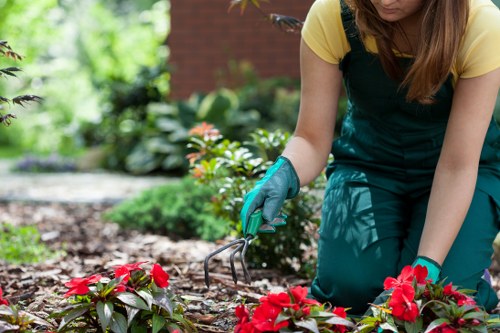Enhancing Garden Fencing with the Right Hedge Trimmer
Introduction to Garden Fencing and Hedge Trimmers

Maintaining a beautiful garden requires not only thoughtful plant selection but also the right tools to shape and care for your outdoor space. Among these tools, a hedge trimmer plays a pivotal role in keeping your garden fencing neat and well-maintained. Whether you have a sprawling estate or a cozy backyard, understanding how to effectively use a hedge trimmer can significantly enhance the aesthetic and functionality of your garden.
Garden fencing serves as more than just a boundary marker; it adds structure, security, and visual appeal to your outdoor area. Pairing it with well-maintained hedges can create a harmonious and inviting environment. This article delves into the importance of selecting the right hedge trimmer for garden fencing, tips for effective trimming, and maintenance practices to ensure longevity and performance.
Choosing the appropriate hedge trimmer involves considering factors such as the type of hedges, the size of your garden, and your personal preferences. From manual to electric and gas-powered models, each type offers distinct advantages tailored to different gardening needs. By the end of this guide, you'll be equipped with the knowledge to make an informed decision and achieve a beautifully manicured garden.
Types of Hedge Trimmers

Manual Hedge Trimmers
Manual hedge trimmers, often resembling scissors or shears, are ideal for precision trimming and shaping of smaller hedges. They offer excellent control and are eco-friendly, requiring no electricity or fuel. However, they may not be suitable for larger gardens or thick, dense hedges.
Electric Hedge Trimmers
Electric hedge trimmers, available in both corded and cordless variants, provide a balance between power and convenience. Corded models ensure consistent performance, while cordless versions offer greater mobility without the hassle of tangled cords. They are perfect for medium-sized gardens and require minimal maintenance.
Gas-Powered Hedge Trimmers
For extensive gardens with thick and robust hedges, gas-powered hedge trimmers are the go-to choice. They deliver substantial power and can handle heavy-duty trimming tasks efficiently. Despite their effectiveness, they are noisier and require regular maintenance, including fuel and engine care.
Choosing the Right Hedge Trimmer for Your Garden Fencing

Assessing Your Garden's Needs
Before selecting a hedge trimmer, evaluate the size and type of your garden fencing. Consider the height and thickness of the hedges you intend to trim, as well as the overall layout of your garden. This assessment will help determine whether a manual, electric, or gas-powered trimmer is most suitable.
Blade Length and Quality
The blade length of a hedge trimmer affects its reach and cutting capacity. Longer blades are advantageous for large hedges and higher fences, while shorter blades offer better maneuverability for intricate shapes. Additionally, high-quality blades made from durable materials ensure precise cuts and longevity.
Ergonomics and Comfort
Since hedge trimming can be time-consuming, selecting a trimmer with ergonomic features is essential for comfort and efficiency. Look for models with lightweight designs, adjustable handles, and anti-vibration technology to reduce fatigue during prolonged use.
Effective Hedge Trimming Techniques

Proper Cutting Methods
To achieve clean and even cuts, adopt the right trimming techniques. Start by outlining the desired shape of the hedge, then proceed to make horizontal and vertical cuts to shape the fencing. Avoid cutting too close to the base to promote healthy growth and prevent damage to the plant.
Maintaining Consistent Heights
Consistency in height enhances the visual appeal of garden fencing. Use guides or string lines to ensure that all sections of the hedge are trimmed uniformly. Regular maintenance trims also prevent overgrowth and maintain the intended shape and size.
Time and Frequency of Trimming
The timing of hedge trimming can influence plant health. Trim during the growing season to encourage bushier growth, and avoid trimming in extreme weather conditions. Depending on the growth rate, aim for trimming every few weeks to keep the fencing well-maintained.
Maintaining Your Hedge Trimmer

Regular Cleaning
After each use, clean the blades and body of the hedge trimmer to remove sap, dirt, and debris. This prevents rusting and ensures optimal performance. Use a brush or cloth to wipe down the surfaces thoroughly.
Blade Sharpening and Replacement
Dull blades can lead to uneven cuts and strain the trimmer's motor. Regularly sharpen the blades using a sharpening stone or file, and replace them when they show signs of excessive wear or damage.
Lubrication and Storage
Lubricate the moving parts of the hedge trimmer to reduce friction and extend its lifespan. Store the trimmer in a dry, sheltered area to protect it from moisture and harsh weather conditions.
Safety Tips for Using Hedge Trimmers
Personal Protective Equipment (PPE)
Always wear appropriate PPE, including gloves, safety goggles, and sturdy footwear, to protect yourself from potential injuries. This gear guards against accidental cuts, debris, and other hazards while trimming.
Operating Procedures
Follow the manufacturer's instructions for operating your hedge trimmer. Ensure that you are familiar with the controls and safety features before use. Avoid overreaching and maintain a balanced stance to prevent accidents.
Environmental Considerations
Trim hedges in calm weather to minimize the risk of debris being blown into your eyes or other unintended areas. Be mindful of your surroundings, especially when using gas-powered trimmers, to prevent damage to nearby plants and structures.
Integrating Hedge Trimming with Garden Fencing Design
Creating Symmetry and Balance
Proper hedge trimming contributes to the symmetry and balance of garden fencing. Uniformly shaped hedges complement the structure of the fence, enhancing the overall design and creating a visually pleasing landscape.
Highlighting Architectural Features
Use hedge trimming to accentuate architectural elements of your garden fencing. Well-shaped hedges can draw attention to corners, gates, and other focal points, adding depth and interest to your outdoor space.
Seasonal Adjustments
Adapt your hedge trimming practices to reflect seasonal changes. Adjust the trimming schedule and techniques to accommodate the growth patterns of different plants, ensuring that your garden fencing remains attractive year-round.
Choosing the Right Plants for Garden Fencing
Evergreen vs. Deciduous Hedges
Selecting between evergreen and deciduous hedges depends on your aesthetic preferences and maintenance capabilities. Evergreen hedges provide year-round privacy and structure, while deciduous hedges offer seasonal beauty and varied textures.
Low-Maintenance Plants
Opt for low-maintenance plants if you prefer minimal upkeep. Species such as boxwood, privet, and laurel are known for their resilience and ease of trimming, making them ideal for busy gardeners.
Flowering Hedges
Incorporate flowering hedges to add color and fragrance to your garden fencing. Plants like forsythia, hydrangea, and lilac not only enhance visual appeal but also attract pollinators and beneficial insects.
Environmental Benefits of Well-Trimmed Garden Fencing
Promoting Plant Health
Regular hedge trimming encourages healthy plant growth by removing dead or diseased branches and promoting air circulation. This practice reduces the risk of pests and diseases, ensuring that your garden fencing remains vibrant and strong.
Enhancing Biodiversity
Well-maintained hedges provide habitats for various wildlife, including birds, insects, and small mammals. Trimming practices that preserve natural shapes and allow for diverse plant structures contribute to a thriving ecosystem in your garden.
Energy Efficiency
Strategically trimmed hedges can act as natural windbreaks and insulators, reducing energy consumption in your home. By minimizing drafts and protecting against extreme weather, they create a more comfortable living environment.
Common Mistakes to Avoid When Trimming Hedgerows
Over-Trimming
Excessive trimming can stress plants, leading to reduced growth and increased susceptibility to diseases. Maintain a balanced approach by only removing a portion of the foliage during each trimming session.
Ignoring Plant Health
Failing to monitor the health of your hedges can result in unnoticed pest infestations or disease outbreaks. Regularly inspect your plants and address any issues promptly to maintain their integrity.
Using Dull Blades
Dull blades can cause uneven cuts and damage plant tissues. Ensure that your hedge trimmer blades are sharp and well-maintained to achieve clean and precise trimming results.
Advanced Hedge Trimming Techniques
Creating Tiered Hedges
Tiered hedges involve creating multiple levels or layers within your garden fencing. This technique adds depth and dimension to your landscape, making it more visually appealing and dynamic.
Topiary Art
Topiary involves shaping hedges into intricate and artistic forms, such as animals, geometric shapes, or abstract designs. This advanced technique showcases your creativity and adds a unique flair to your garden fencing.
Seasonal Styling
Adapt your hedge trimming styles to reflect different seasons. For instance, create fuller, bushier shapes in spring and adopt sleeker lines during the winter months to complement seasonal changes.
Conclusion
Investing in the right hedge trimmer and applying effective trimming techniques are essential for maintaining beautiful and functional garden fencing. By understanding the various types of trimmers, selecting appropriate plants, and adhering to proper maintenance practices, you can enhance the aesthetic and environmental value of your outdoor space.
Remember to prioritize safety and environmental considerations while trimming, and don't hesitate to consult with gardening professionals if needed. A well-kept garden not only boosts curb appeal but also provides a serene retreat for you and your family.
Ready to take your garden fencing to the next level? Contact us today to explore the best hedge trimmers and gardening solutions tailored to your needs.